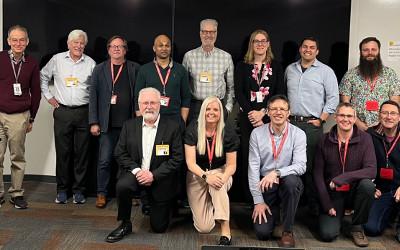£1.3 million grant awarded to develop world-leading technologies in planetary imaging

The Open University (OU) Atmospheric Research and Surface Exploration group, led by Professor Manish Patel, have been awarded a £1.3 million grant from the UK Space Agency for developing new UK detector technology to realise next-generation planetary imaging through an international partnership with the US. This contribution to the world-leading imager instrument, called HiRISE2, will eventually replace decade old imagers currently orbiting the Moon and Mars.
The OU team will build on the international partnership between University of Arizona and Ball Aerospace and combine areas of UK and US excellence in remote sensing of planetary bodies. This work will see the OU, XCAM Ltd and Teledyne e2v UK develop the CIS125 detector in partnership with the University of Arizona and Space & Mission Systems of BAE Systems, Inc. (formerly known as Ball Aerospace Technologies Corporation), based in the USA.
Global scientific interest
OU involvement in the HiRISE2 instrument will bring global scientific interest through the provision of decimetre-scale imaging of the Moon and Mars, and notably raise the profile of the UK in both the planetary science and human space exploration community. Profesor Patel, who leads the overall study, said, “This significant funding we have been awarded conveys the reputation of the OU and the UK as a world-leader in cutting-edge detector technology and space research. This project will help deliver a new era of high-resolution imaging of the Moon and Mars, in advance and in support of human presence on both planetary bodies, in the coming years.”
Eyes on the Moon and Mars
Human exploration of the Moon and Mars is the very highest priority goal of NASA with new orbital missions carrying ultra-high-resolution imagers currently being planned. The original HiRISE instrument has operated at Mars for nearly two decades, providing 80,000 images of the surface of Mars. It has also contributed to assessing landing sites of NASA and European Space Agency Mars rovers and landers, ensuring a safe terrain for vehicles to land through its high-resolution imaging capability. It is anticipated that HiRISE2 will create similar if not greater impact through improved imaging of the lunar and martian surface.
Dr James Ivory, from the Centre for Electronic Imaging, will lead the laboratory testing of the CIS125 detector and commented, “The long-term nature of planetary science and human exploration of the Moon and Mars means that this funding represents an exciting and sustained technical and scientific collaboration between UK and US industry and Academia.”
The OU team working on this project includes Professor Manish Patel, Dr Konstantin Stefanov, Martyna Hodges, Dr. James Ivory, Imane Dazzazi, Dr Jon Mason and Dr Mark Leese.
Quarterly Review of Research
Read our Quarterly Review of Research to learn about our latest quality academic output.

Contact our news team
For all out of hours enquiries, please telephone +44 (0)7901 515891
Contact detailsNews & articles

OU received £560k UKRI funding for bold project on democratising higher education
The Open University has been awarded £560,000 by UK Research and Innovation to lead a pioneering research project that interrogates the future of university governance in a neoliberalised higher education landscape.